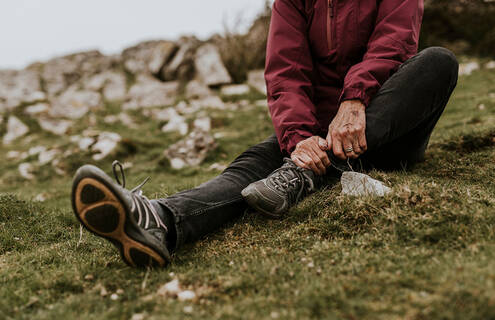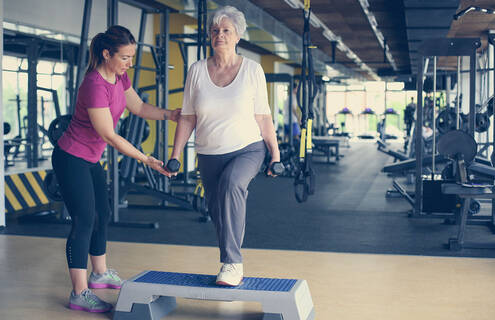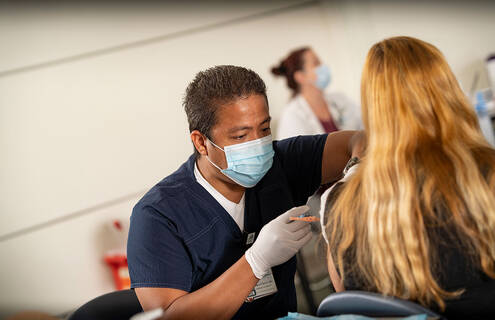
You twist your ankle hiking or pull a hamstring playing pickleball.
Chances are you used a popular remedy called RICE. It was once the go-to approach for treating acute injuries like sprains, tendonitis and lower back pain.
RICE was a term coined by Gabe Mirkin, MD, who published "The Sports Medicine Book" in 1978. Nine years ago, Mirkin recanted his advice for RICE, saying ice and total rest can actually hurt instead of help.
"RICE can decrease symptoms but is unlikely to improve your recovery time significantly. There is no definitive research proving its effectiveness." says Scott E. Klass, MD, MS. an orthopaedic doctor at Dartmouth Hitchcock Medical Center.
If RICE isn't the answer, what is?
Inflammation is the body's way to start healing
"It's easy to panic if you're hurt. But the body can do amazing things to heal itself," says Alison Trow, PT, a physical therapist at DHMC.
When you're injured, your body triggers an inflammatory response, prompting blood vessels to dilate so white blood cells can flood the injury site.
Those white blood cells help eliminate damaged tissue and fight off potential infections. The accompanying inflammation you feel—which causes swelling or pain—is a natural, protective body response to help you heal.
What about MEAT, MICE, PEACE and LOVE?
What does MEAT, MICE, and PEACE and LOVE stand for?
- MEAT stands for movement, exercise, analgesia (using pain relief medication), and treatment.
- MICE is movement, ice, compression, and elevation.
- PEACE and LOVE is protect, elevate, avoid anti-inflammatory medication, compression, and educate (PEACE), and load, optimism, vascularization, and exercise (LOVE).
Several remedies have surfaced since RICE's debut 46 years ago. MEAT, MICE and PEACE and LOVE share themes around movement and treatment. There are differences, as some call for pain relief medication while others don't.
"These are all mainly a twist on the RICE treatment," says Brian Frenkiewich, DO, a primary care provider at New London Hospital. "Most of this comes down to common sense. If something hurts to do, then don't do it. Seek treatment if you need to and get moving as soon as you can."
Subscribe to the Living Better newsletter
Your trusted resource for reliable and up-to-date health and wellness information in the Northeast. Get it delivered to your inbox every other week.
Rest is not necessarily best
"We used to prescribe bed rest when someone had back pain. Looking back, that was probably the worst thing to do," Trow says. "Now we know you need to move your body to help heal."
Rather than total rest, things like exercise, physical therapy and walking can help promote blood flow and prevent muscle atrophy.
"You don't want to do what made your hand, back or ankle angry in the first place. But don't immobilize it either," Frenkiewich says.
Complete rest is not required for most common soft tissue injuries. But while taking it too easy can slow the healing, pushing through the pain is likely detrimental as well.
"My mantra is usually to rest it for comfort, but as soon as the injured part of your body starts feeling a little better, you want to get it moving."
Maybe think twice about ice
Treating an injury with ice is a bit of a mixed bag.
"Icing is more about comfort than treating inflammation," Frenkiewich says.
Some research shows that icing an injured area can hinder healing. A long period of applying cold to the skin—intended to numb the area and reduce inflammation—can curtail blood flow and potentially harm soft tissue.
But Frenkiewich points out that certain body parts can take nearly an hour to cool from ice. That's because your body naturally tries to keep it warm even as you're icing.
"Using ice for comfort is fine," he says. "In most places of the body, there's no harm because the effects of the ice aren't getting deep enough."
For comfort, heat is another helpful option for easing muscle pain and stiffness, he says. Other suggestions to reduce pain include integrative medicine therapies, like lymphatic drainage massage and acupuncture.
If you have prolonged discomfort, see a physical therapist. Experts like Klass offer platelet-rich plasma (PRP) injections, a therapy that uses a patient's platelets to accelerate the healing of damaged joints, ligaments, tendons or muscles.
"It's less invasive than surgery and often patients can get back to activity quicker afterward," Klass says.
What about compression and elevation?
The last two letters in RICE stand for compression and elevation.
Compression can help reduce pain and swelling and improve blood and fluid circulation. Elevating the injured body part can lower the pressure in local blood vessels and help with drainage.
But a World Journal of Orthopedics 2020 study found no scientific evidence that compression and elevation do much.
There's no harm in it either. The same study pointed out that RICE therapy is a reasonable and safe method for short-term pain relief, as long as it helps you get moving.
The bottom line?
"Your body is an amazing machine," Trow says. "And it's going to tell you if it's not ready to get back out there."


